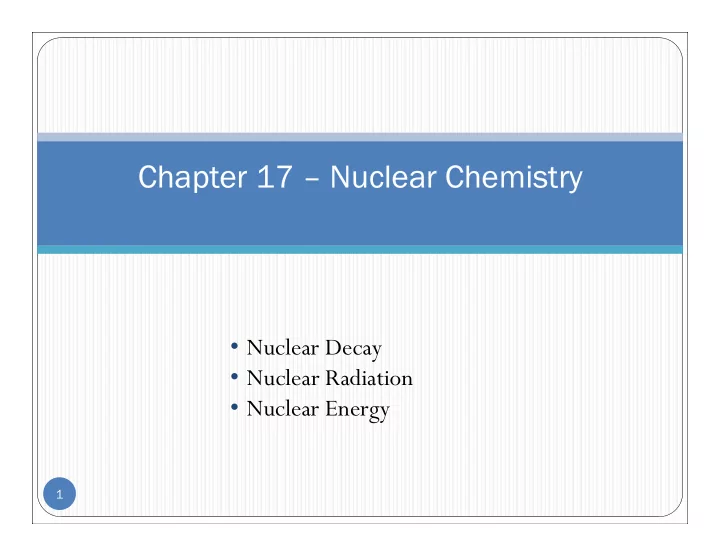

Chapter 17 – Chapter 17 – Nuclear Chemistry uclear Chemistry • Nuclear Decay • Nuclear Radiation • Nuclear Energy 1
Nuclear Decay Nuclear Decay History History Henri Becquerel stored uranium oxide in a drawer with photographic plates. The uranium oxide darkened the plates therefore the uranium oxide must have given off 2 some type of radiation
Nuclear Decay Nuclear Decay History History Ernest Rutherford passed the radiation through two electrically charged plates and found that the radiation was made up of three primary particles ( α , β , and γ ) each having a different charge. 3
Nuclear Decay Nuclear Decay Types of Particles Types of Particles Scientists have discovered other types of particles but these types of radiation are far less common than α , β , and γ radiation. 4
Nuclear Decay Nuclear Decay Elemental Amounts Elemental Amounts The number of elements with even atomic numbers are more abundant than the elements with odd atomic numbers. 5
Nuclear Decay Nuclear Decay Elemental Amounts Elemental Amounts A band of stability is found with a sea of instability at either side. For low atomic number the band of stability lies on the A = 2Z line. As the atomic number increases the protons repel each other more making it necessary for more neutrons 6 to be present in the nucleus.
Nuclear Decay Nuclear Decay Radioactive Series for U-238 Radioactive Series for U-238 Radioactive series is a series of radioactive decays that a nuclei undergoes until a stable nucleus is formed. 7
Nuclear Energy Nuclear Energy Binding Energy Binding Energy A plot of the binding energy per nucleon vs. atomic number shows that the nucleons that are most strongly bonded together are near iron and nickel. This is one of the reasons that iron and nickel are abundant in meteorites and on rocky planets such as earth. Suggesting that nuclei of lighter atoms become more stable when they “fuse” together and that the heaver nuclei become more stable when they undergo “fission” and split into lighter nuclei. 8
Nuclear Energy Nuclear Energy Spontaneous Nuclear Fission Spontaneous Nuclear Fission Spontaneous nuclear fission takes place when the natural oscillation of a heavy nucleus causes it to break into two nuclei of similar mass. An example is the disintegration of americium-244 into iodine and molybdenum. 95 Am � 134 244 53 I + 107 42 Mo + 3 1 0 n 9
Nuclear Energy Nuclear Energy Fission Yield for Uranium-235 Fission Yield for Uranium-235 Fission does not happen the same way every time. The fission yield of uranium-235 mainly yields products close to A=90 and A=130 and relatively few nuclide corresponding to symmetric fission (close to 117) are formed. 10
Nuclear Energy Nuclear Energy Nuclear Power Plant Nuclear Power Plant 11
Nuclear Energy Nuclear Energy Binding Energy Binding Energy It can be seen that there is a large increase in nuclear binding energy per nucleon going from one lighter element to another. Consequently a large amount of energy is released when hydrogen nuclei fuse together to form nuclei of bigger elements. 12
Recommend
More recommend